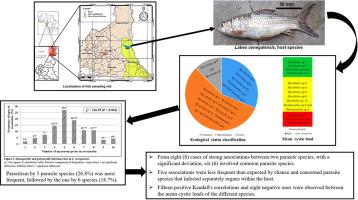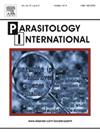Diversity, ecological status and species associations of myxozoans (Cnidaria: Myxosporea) parasites of Labeo senegalensis Valenciennes, 1842 (Cyprinidae) from lake Maga in Cameroon
IF 1.9
4区 医学
Q3 PARASITOLOGY
引用次数: 0
Abstract
Classical parasitological methods, including fish autopsy and search of myxozoan species, were applied to examine 229 specimens of Labeo senegalensis collected monthly from Lake Maga, Cameroon, between October 2018 and August 2019. The myxosporean fauna of L. senegalensis was diverse and abundant, with 16 species recorded. Among these, Myxobolus sp.2, Myxobolus sp.6, Myxobolus sp.10, Thelohanellus sp.2, and Thelohanellus sp.3 were common. Intermediate occurrence was observed for Myxobolus sp.1, Myxobolus sp.3, Myxobolus sp.4, Myxobolus sp.5, Myxobolus sp.7, Myxobolus sp.8, Myxobolus sp.11, Thelohanellus sp.1 and Thelohanellus sp.4, whereas Myxobolus sp.9 and Myxidium sp. were scarce. The mean cyst load was high for Myxobolus sp.2, Myxobolus sp.5 and Thelohanellus sp.1; low for Myxobolus sp.3, Myxobolus sp.4, Myxobolus sp.6, Myxobolus sp.8, Myxobolus sp. 11, Thelohanellus sp.2 and Thelohanellus sp.3; and very low for Myxobolus sp.1, Myxobolus sp.7, Myxobolus sp.9 and Thelohanellus sp.4. Multiple infections were common: parasitism by five species occurred most frequently (26.8 %), followed by parasitism by six species (18.7 %). Monospecific infections were rare, with only four cases (1.8 %) recorded. Dice's coefficient combined with Forbes' index revealed eight strong associations between pairs of parasite species, significantly deviating from random expectations; six of these involved common parasite species. Conversely, five associations were less frequent than expected and involved species that typically colonized distinct host organs. Analysis of cyst load correlations indicated 15 positive and 8 negative Kendall's rank correlations among species. These findings suggest that polyspecific infections and positive interspecific interactions may contribute substantially to the pathogenic potential of myxozoan parasites in L. senegalensis.

喀麦隆Maga湖1842年塞内加尔拉比(Labeo senegalensis Valenciennes)粘虫(刺胞目:粘孢子目)寄生虫的多样性、生态状况及物种关联
2018年10月至2019年8月期间,研究人员采用经典的寄生虫学方法,包括鱼类解剖和黏液动物物种搜索,对每月从喀麦隆Maga湖采集的229份塞内加尔拉贝(Labeo senegalensis)标本进行了研究。塞内加尔l.s enegalensis黏液孢子动物区系丰富多样,共记录有16种。其中以Myxobolus sp.2、Myxobolus sp.6、Myxobolus sp.10、theelohanellus sp.2和theelohanellus sp.3较为常见。粘虫(Myxobolus sp.1)、粘虫(Myxobolus sp.3)、粘虫(Myxobolus sp.4)、粘虫(Myxobolus sp.5)、粘虫(Myxobolus sp.7)、粘虫(Myxobolus sp.8)、粘虫(Myxobolus sp.11)、粘虫(theelohanellus sp.1)和粘虫(theelohanellus sp.4)中等分布,而粘虫(Myxobolus sp.9)和粘虫(Myxobolus sp.4)较少。Myxobolus sp.2、Myxobolus sp.5和theelohanellus sp.1的平均囊负荷较高;低为Myxobolus sp.3、Myxobolus sp.4、Myxobolus sp.6、Myxobolus sp.8、Myxobolus sp. 11、theelohanellus sp.2和theelohanellus sp.3;而Myxobolus sp.1、Myxobolus sp.7、Myxobolus sp.9和theelohanellus sp.4极低。多重感染较为常见,以5种寄生虫寄生最多(26.8%),其次为6种寄生虫寄生(18.7%)。单特异性感染很少见,仅记录了4例(1.8%)。Dice的系数与福布斯指数相结合,揭示了成对寄生虫物种之间的八个强关联,明显偏离了随机预期;其中6个涉及常见的寄生虫种类。相反,5种关联的频率低于预期,并且涉及通常定殖于不同寄主器官的物种。囊负荷相关分析显示,各物种间肯德尔等级呈正相关15个,负相关8个。这些发现表明,多种感染和种间的积极相互作用可能是塞内加尔l.s neegalensis黏液寄生虫致病潜力的重要原因。
本文章由计算机程序翻译,如有差异,请以英文原文为准。
求助全文
约1分钟内获得全文
求助全文
来源期刊

Parasitology International
医学-寄生虫学
CiteScore
4.00
自引率
10.50%
发文量
140
审稿时长
61 days
期刊介绍:
Parasitology International provides a medium for rapid, carefully reviewed publications in the field of human and animal parasitology. Original papers, rapid communications, and original case reports from all geographical areas and covering all parasitological disciplines, including structure, immunology, cell biology, biochemistry, molecular biology, and systematics, may be submitted. Reviews on recent developments are invited regularly, but suggestions in this respect are welcome. Letters to the Editor commenting on any aspect of the Journal are also welcome.
 求助内容:
求助内容: 应助结果提醒方式:
应助结果提醒方式:


